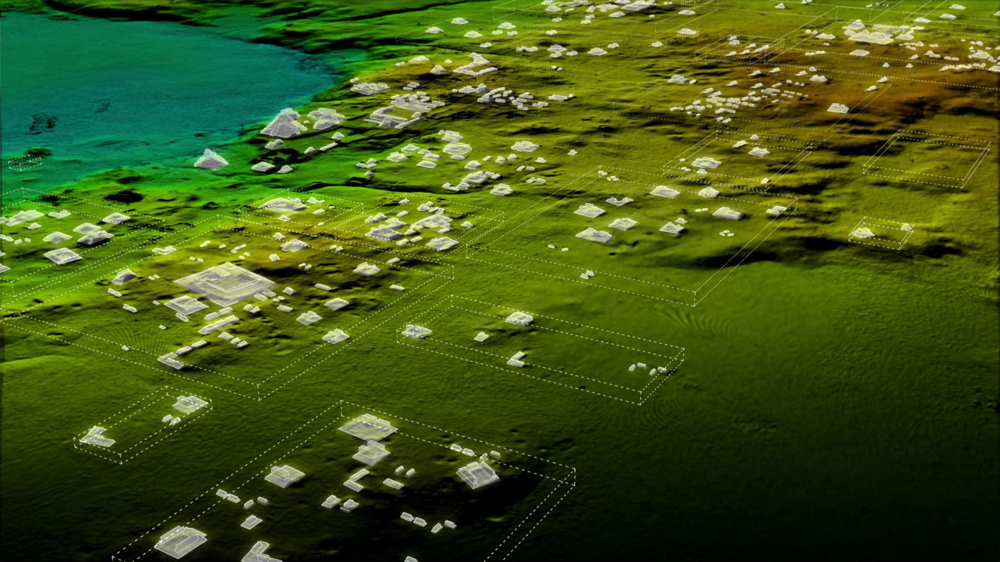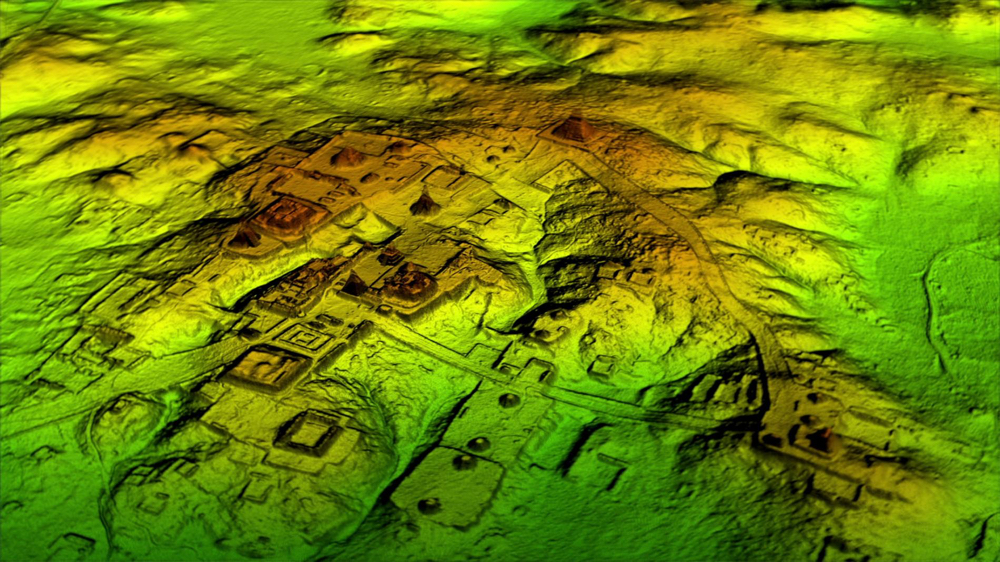Generally accepted Western conceits about the possible size and scope of tropical civilizations continue to be shattered with the help of high-powered 3D scanning technology and organizations like PACUNAM, Guatemala’s Mayan Heritage and Nature Foundation. Last year their researchers employed state-of-the-art aerial mapping technology called LiDAR (Light Detection And Ranging) at the archaeological site at Tikal and discovered the ruins of more than 60,000 structures that have been hidden under the massive jungle canopy for more than 1,200 years. The hidden structures included homes, palaces, waterways, quarries, terraced agriculture and elevated roadways connecting the sprawling civilization together. Until recently experts believed that the dense vegetation and terrain of the jungles in northern Guatemala had limited the size that ancient Mayan cities like Tikal would be able to support. However the vast network of interconnected structures hidden under the jungle revealed signs of much larger civilizations, rivaling those of ancient Greece and China.
“Most people had been comfortable with population estimates of around 5 million. With this new data it’s no longer unreasonable to think that there were 10 to 15 million people there—including many living in low-lying, swampy areas that many of us had thought uninhabitable.” explained Francisco Estrada-Belli, a Tulane University archaeologist and the director of a multi-disciplinary archaeological project at Holmul, Guatemala.
PACUNAM mapped an area of 800 square miles inside the massive Maya Biosphere Reserve located in the Petén region of Guatemala and produced the largest LiDAR data set ever collected for an archaeological research project. The pre-Columbian civilization that they discovered under the tree canopy extended further than previously considered. Most ground-based research of the area believed that the region supported several smaller, scattered city states. However what they found had far more complexity and interconnecting roadways than was generally considered possible in tropical climates.
“We’ve had this western conceit that complex civilizations can’t flourish in the tropics, that the tropics are where civilizations go to die. But with the new LiDAR-based evidence from Central America and [Cambodia’s] Angkor Wat, we now have to consider that complex societies may have formed in the tropics and made their way outward from there,” said Tulane University archaeologist Marcello Canuto, who participated in the project as a National Geographic Explorer.
 The discovery mirrors that massive ancient city discovered surrounding the Angkor Wat temple complex in Cambodia back in 2016 and once again 3D scanning technology is revolutionizing how we learn about our ancient past. The LiDAR technology that was used allows researchers to basically see through thick jungle canopy and heavy vegetation using high-powered 3D scanning lasers and map the ground below it. The PACUNAM researchers mounted the lasers underneath small aircraft, pointed them to the ground and fired them hundreds of times while they flew over the Maya Biosphere Reserve. Once all of the data was collected it was processed using software that can differentiate between tree cover and the ground. Once the trees and vegetation were removed it revealed the expansive remains of ancient foundations and structures that still survive.
The discovery mirrors that massive ancient city discovered surrounding the Angkor Wat temple complex in Cambodia back in 2016 and once again 3D scanning technology is revolutionizing how we learn about our ancient past. The LiDAR technology that was used allows researchers to basically see through thick jungle canopy and heavy vegetation using high-powered 3D scanning lasers and map the ground below it. The PACUNAM researchers mounted the lasers underneath small aircraft, pointed them to the ground and fired them hundreds of times while they flew over the Maya Biosphere Reserve. Once all of the data was collected it was processed using software that can differentiate between tree cover and the ground. Once the trees and vegetation were removed it revealed the expansive remains of ancient foundations and structures that still survive.
“The LiDAR images make it clear that this entire region was a settlement system whose scale and population density had been grossly underestimated,” explained Ithaca College archaeologist and National Geographic Explorer Thomas Garrison, who specializes in applying digital technology to archaeological research.

Among the 60,000 structures discovered included waterways, roads, farms and military fortifications.
The sheer scale and size of the structures that were found make this the largest discovery of its kind, and it is going to radically alter how we look at the Mayans and other early tropical settlements. In addition to the hundreds of structures and homes that were found the researchers found evidence of elaborate raised roads that connected urban centers with agricultural sites and quarries. The causeways were specifically engineered to be raised off the ground so they could be used even during the rainy season when large patches of the ground would have been flooded. These roads were heavily used despite the Mayans not having discovered the wheel and having no large domesticated animals to help transport crops or stone as beasts of burden.
In addition to the road networks, the Mayans also spent considerable effort controlling the large amount of water that falls throughout the region with several large canals and waterways. This water was often diverted to the terraced agricultural sites that produced the large amount of food that would have been consumed by the large population. The researchers also discovered evidence of large military garrisons, defensive walls and fortresses. War seemed to be a regular way of life for many of the residents of the ancient city, and the evidence of their expansive military structures underline how pervasive and omnipresent it was.
“LiDAR is revolutionizing archaeology the way the Hubble Space Telescope revolutionized astronomy. We’ll need 100 years to go through all [the data] and really understand what we’re seeing,” said Estrada-Belli, who is also a National Geographic Explorer.

The same ruins as above with the complex of hidden structures and roadways that connected them revealed with LiDAR technology.
Despite the size of the discovery, this is only the first phase of PACUNAM’s planned LiDAR Initiative. The 3-year project is planning to completely map a 5,000-square-mile area that extends through the Guatemalan lowlands all the way to the Gulf of Mexico. Not only will this give the researchers a larger view of what the pre-Columbian settlements that extend throughout the area looked like in size and scale, but it allows them to identify key dig sites that they never would have found using traditional mapping methods. The researchers will also be able to get a larger look at the environmental impact of local deforestation and urban sprawl throughout the region.
You can read more about how LiDAR was used to uncover the cities surrounding Angkor Wat here, and you can read more about National Geographic and PACUNAM’s use of LiDAR technology in Guatemala here.
Discuss this and other 3D printing topics at 3DPrintBoard.com or share your thoughts below.
[Source/Images: National Geographic]
Subscribe to Our Email Newsletter
Stay up-to-date on all the latest news from the 3D printing industry and receive information and offers from third party vendors.
You May Also Like
Precision at the Microscale: UK Researchers Advance Medical Devices with BMF’s 3D Printing Tech
University of Nottingham researchers are using Boston Micro Fabrication‘s (BMF) 3D printing technology to develop medical devices that improve compatibility with human tissue. Funded by a UK grant, this project...
3D Printing Webinar and Event Roundup: April 21, 2024
It’s another busy week of webinars and events, starting with Hannover Messe in Germany and continuing with Metalcasting Congress, Chinaplas, TechBlick’s Innovation Festival, and more. Stratasys continues its advanced training...
3D Printing Webinar and Event Roundup: March 17, 2024
It’s another busy week of webinars and events, including SALMED 2024 and AM Forum in Berlin. Stratasys continues its in-person training and is offering two webinars, ASTM is holding a...
3D Printed Micro Antenna is 15% Smaller and 6X Lighter
Horizon Microtechnologies has achieved success in creating a high-frequency D-Band horn antenna through micro 3D printing. However, this achievement did not rely solely on 3D printing; it involved a combination...
































